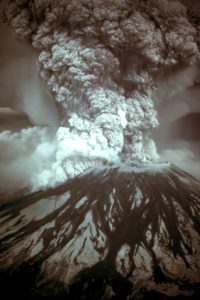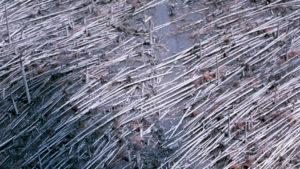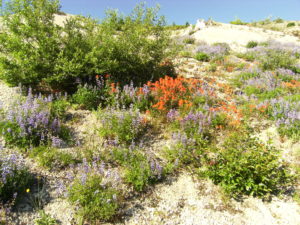David A. Johnston, a U.S. Geological Survey scientist, was camped near Mount St. Helens on the morning of May 18, 1980. He had been stationed there to monitor smaller earthquakes and eruptions on the mountain over the previous several months. That morning, at 8:32, he radioed, “This is it!” And it was. Mount St. Helens erupted that morning, destroying 200 the surrounding landscape and killing 57 people, including Johnston.
Mount St. Helens, in central Washington, was one of the beautiful, cone-shaped mountains of the Cascades, standing tall at 9600 feet above sea level. The mountain, like others in the volcanically active Cascade Range, had experienced eruptions before, one around 1800 that might have been bigger than the modern eruption. But this one was different. A magnitude-5.1 earthquake under the mountain dislodged the north-facing slope, creating the largest landslide ever recorded—anywhere on earth. Then the volcano erupted through the barren flank, sending a wave of rock and ash sideways, instantly destroying 200 square miles of forest. Eruptions followed from the top of the mountain, spewing ash and smoke 12 miles into the air. The mountain’s height dropped by 1300 feet. A wave of mud moved across the landscape at 90 miles per hour.

The destruction to the ecosystem was enormous. In the blast zone, trees were laid flat; 4 billion board-feet of timber were lost, enough to build 500,000 homes. Spirit Lake, just below the mountain, was covered in ash and completely disappeared, along with 15 miles of the North Fork Toutle River. Along with the 57 human fatalities, an estimated 11 million fish, 1 million birds and about 20,000 large mammals perished. The federal government estimated the total damage at $1.1 billion.

The eruption itself is a testament to the power of nature, but even more remarkable is the recovery. Observers at the time expected recovery of the ecosystem to take generations, perhaps centuries. But once again, nature demonstrated the power and resilience of natural processes. The federal government created the Mount St. Helens National Volcanic Monument (a U. S. Forest Service property) so that scientists could study the natural recovery process.
The pace and scope of recovery have surprised everyone. Within days, insects had returned. Within weeks, plants were sprouting. Lupines, which are able to fix nitrogen from the air and thus take advantage of the available landscape, populated quickly, their beautiful flowered stalks decorating the ashy grey ground. The river quickly reformed a channel to carry melting water and rainwater from the newly sculpted mountainside. Likewise, Spirit Lake began to reform, capturing the runoff water. Elk have returned to graze on the lush vegetation.

Today, nearly 40 years after the eruption, the Mount St. Helens ecosystem is a laboratory that challenges much of what we had thought about succession. The ecosystem is not the same, so the ecological processes are less about recovery than about creation. Spirit Lake, for example, which had been a relatively barren cold-water lake is now shallower, more productive and more diverse. Coniferous forests have been replaced in many areas by deciduous forests of alders, which also can fix nitrogen from the air.
The lesson, I believe, is not that nature is fragile, but that nature is tough. A physical process like a volcano, earthquake, flood or drought may have profound acute impacts, but the persistent and patient biological processes that follow will create a new ecosystem as interesting, beautiful and productive as the one it replaced. In the end, nature wins.
References:
Bagley, Mary. 2013. Mount St. Helens Eruption: Facts & Information. Live Science, February 23, 2013. Available at: https://www.livescience.com/27553-mount-st-helens-eruption.html. Accessed May 18, 2018.
Casey, Michael. 2015. 35 years after Mount St. Helens eruption, nature returns. CBS News, May 18, 2015. Available at: https://www.cbsnews.com/news/35-years-after-mt-st-helens-eruption-nature-returns/. Accessed May 16, 2018.
Lindsey, Rebecca. 1984. Devastation and Recovery at Mt. St. Helens. NASA Earth Observatory, June 17, 1984. Available at: https://earthobservatory.nasa.gov/Features/WorldOfChange/sthelens.php. Accessed May 18, 2018.
Swenson, Keith and David Catchpoole. 2012. After devastation … the recovery. Creation Ministries International, 14 November 2012. Available at: https://creation.com/after-devastation-the-recovery. Accessed May 18, 2018.
